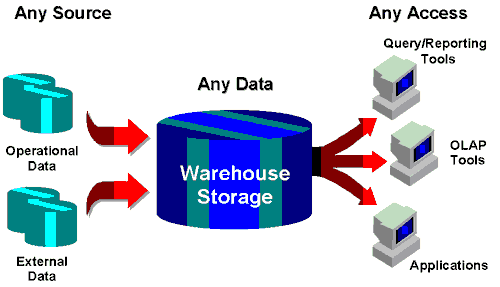Explore New Dimensions
1. Introduction
The information revolution is underway. Organizations are generating and storing unprecedented amounts of data about their day to day operations. A new paradigm must be uncovered to reign in and harness these vast amounts of data. Furthermore, it is not enough to simply collect and collate large amounts of data without putting it to good use. With the advent of data warehousing, organizations have begun to discover new ways of turning data into a valuable resource. As the leader in providing information technology, Oracle is at the fore with an array of technologies to assist in gaining the benefit from data warehouses. Decision makers at all levels of the organization must be able to access and manipulate data in such a way that it can be transformed into an organization's most valuable asset: information. Oracle Discoverer™ is the tool that allows business users to turn data into information.
2. Data Warehousing
Recent surveys indicate that over 90% of mid to large sized organizations will set up a data warehouse this year. According to IDC, approximately 80% of organizations that have already invested in data warehousing, view them as a major success. Why? A data warehouse provides a distinct centralized repository from OLTP systems that contains extracts of vital business data from a variety of corporate databases. This data is analyzed and used as a strategic competitive weapon. Fast, accurate analysis of business issues affect long term survival. For example, analyzing trends in geographic demand patterns allowed one organization to regulate supplies accordingly and increase sales by over $2 Million.
Unlike those of operational systems, data structures in a data warehouse are optimized for rapid retrieval and analysis. The data is historical and is updated at some regular interval.
There are 3 general steps to defining, creating and using a data warehouse:
1) Model end user business needs. The designers of the warehouse must obtain information needs from the various business users. The designers translate these information needs into a warehouse model. Designers must take a rigorous and disciplined approach to ensure completeness of the model.
2) Model meta-data. In conjunction with modeling the end users' needs, warehouse designers must also model meta-data (data about the data). This information defines the data going into the data warehouse and the rules associated with this data. Since the data warehouse is subject oriented, this modeling of meta data might cross functional business areas. The meta data falls into two categories: loading and user.
a) Loading view: This describes all the data sources and all the rules for extracting, scrubbing, and transporting data to the warehouse.
b) End user view: Here, the model matches the business uses of the data. This is the floor plan of the warehouse that end users use to access and explore their information.
3) Evaluate, determine, and implement extraction, transformation, and access tools. Once designers have established a model of the end user needs and accompanying meta data in the repository, tools must be chosen for stocking the data warehouse. The final decision entails selecting the tools that end users will work with to access the information stored in the warehouse.
3. The Oracle Warehouse
The Oracle Warehouse consists of a suite of products and services that span the entire process of defining, designing, and implementing a data warehouse. The figure below shows the components in the Oracle Warehouse:

Figure 1 - The Oracle Warehouse
Any Source. The data collected in the Oracle Warehouse can come from a variety of sources, including both operational (internal) and external. Traditionally, most of the data in a warehouse has come from internal operational systems such as order entry, inventory, or human resource data. However, external sources (demographic, economic, internet) are becoming more and more prevalent and will soon be providing more content to the data warehouse than the internal sources. Both sources must be harnessed and melded into a single storage container to provide end users with seamless access to both kinds of data.
Any Data. Because of the breadth of users now involved with accessing the data warehouse, system designers are faced with a diverse set of requirements. Access to the data must be fast, straightforward, and intuitive. The mass of users require straightforward query and drill capabilities, while others require more sophisticated analytical capabilities. The data source must be able to handle new formats of data such as audio, video, text and spatial. Furthermore, vast historical requirements from an increasing number of users frequently leads to very large databases (VLDBs). To satisfy these requirements, Oracle provides both a relational (Oracle7) and a multidimensional (Express Server) solution.
Any Access. Oracle offers a comprehensive suite of tools that allows all types of users to access the data held in the warehouse, including: ad hoc querying and reporting, drill-down and pivot, and full analysis (modeling, forecasting, what-if analysis, etc.). The majority of users need a straightforward, intuitive tool that allows them to easily access the data to make common business decisions. A separate set of analytical users need to do more sophisticated, lengthy analysis in support of business strategies. Taken together, the need to access the information spans an entire organization. The data warehouse of today has moved from the executive and analyst domain to include this broad category termed knowledge workers. This evolution is a direct result of pushing authority down the command chain; flattening the organization. Given the more prominent role of the knowledge worker, the decision on which tools to implement becomes much more critical.
To address this diverse set of knowledge worker needs, Oracle provides a unique and complete set of business end user access tools.
Oracle Discoverer™ is the end user query, reporting, drill/pivot, and web publishing tool that allows users to gain rapid access to the relational data warehouse allowing them to make more informed business decisions.
Express AnalyzerTM is the end user Analysis and web access tool that provides sophisticated analysis capabilities such as forecasting, modeling and what-if analysis.
Express ObjectsTM is an OLAP development tool, tightly integrated with Express Analyzer.
4. Oracle Discoverer™ - Product
Architecture Overview

Figure 2 - Oracle Discoverer™ Architecture
Oracle Discoverer™ is comprised of 3 main elements:
1) User Edition
2) Administration Edition
3) End User LayerTM
4.1 Oracle Discoverer™ - User Edition
The User Edition enables users to query the warehouse, graph results, create reports, perform drill and pivot analysis and publish results to the World Wide Web. Given such a fundamental role, this module must meet a number of end user requirements.
During design and development of the End User component, Oracle focused in 3 key areas:
- Ease of Use
- Performance
- Flexible Warehouse Exploration
4.1.1 Ease of Use
For non-technical, business-oriented end users, usability of access tools is the single most important consideration. Oracle Discoverer™ provides a unique interface, where you interact directly with the data you are familiar with. There is no requirement to go to a separate conceptual dialogue to pivot, or a separate “drill mode” to drill.
4.1.1.1 User Interface Development
A Unique Approach.
Traditionally, engineering focus has been primarily on the technical integrity of the product being built. As an integral part of development of Oracle Discoverer™, the software engineers were exposed to customer and user feedback in a variety of ways. Such exposure introduced a newfound understanding of the manner in which end users would like to interact with their data warehouse access tools. Based upon this understanding, an entirely new approach to development was taken with Oracle Discoverer™.
Prototyping Design Possibilities.
Early in the development process for Oracle Discoverer™, paper prototypes were used extensively by a specialized group of User Interface design professionals. Paper prototypes of the user interface were shown to testers, marketers, product managers and potential customers in an effort to solicit input on areas such as ease of use and intuitiveness. Based on this early feedback, the proposals evolved until a basic prototype design was settled upon.
Focus Groups and StoryBoards.
Once the paper design phase for Oracle Discoverer™ was completed, the User Interface (UI) design group used software to build `mock' screens or StoryBoards in order to solicit more advanced feedback about how users interact with the tool. The purpose of the Focus Group was to gain a better understanding of a user's thought process when faced with performing a specific task. For example, `How do I extract information about last years sales figures for the East and West Region and produce a meaningful report with summary totals?' The user interface continued to be tailored according to this feedback. Once the members of the UI design team were satisfied with the interface, the software engineers started coding.
Usability Laboratories.
The usability focus of Oracle Discoverer™ did not stop with Focus Groups. Throughout the development of the project, the UI design team has run several usability tests with a broad range of users from various technical backgrounds. This ensured the development team received constant iterative feedback and could keep focus on the usability of the product. Usability testing allows developers to further refine the interface by providing real-world insight into issues and concerns that affect end users. Current and future development of Oracle Discoverer™ will continue to leverage the benefits of extensive usability testing.
4.1.1.2 Usability
The net result of this innovative approach to development is an interface that provides unsurpassed usability with an intuitive look and feel.